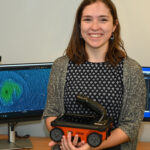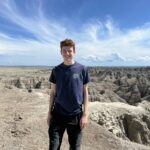Crew 288 – Phobos
Dec 9th, 2023 – Dec 23rd, 2023
Crew Members:
Commander and Crew Astronomer: Dr. Cesare Guariniello
Executive Officer: Riley McGlasson
Crew Geologist: Hunter Vannier
Crew Engineer: Jesus Adrian Meza Galvan
Health and Safety Officer: Jilian Welshoff
Green Hab Officer: Ryan DeAngelis
Crew Journalist: Lipi Roy
Mission Plan:
The twin “Phobos” (288) and “Deimos” (289) missions are the sixth and seventh all-Purdue crew at MDRS. The enthusiasm and interest raised by the previous experiences of Purdue students and alumni at the station, the numerous high-quality research projects carried on at MDRS, as well as Purdue’s honored tradition in the field of space exploration, granted us two back-to-back rotations.
Crew 288 will perform various research tasks, with a strong geological focus, augmented by engineering projects, astronomical observations, and analysis of human factors. Some of the experiments will be performed inside the MDRS modules, while others require Extra Vehicular Activities (EVA), thus adding realistic difficulties to the task. As usual, the combination of excursions and life inside the habitat will provide crew members with the opportunity to both working on their research and identifying potential difficulties of working with space suits and living in close quarters in a small habitat.
The main objectives of the Phobos analog Martian mission are:
Keeping the highest level of fidelity and realism in the simulation. Earth analogs cannot reproduce Martian gravity and atmosphere, but the crew will keep every other aspect into consideration. This includes safety and research protocols, definition of roles and daily schedule, EVA protocols (and limitations), communication protocols, fruitful collaboration with the program director and mission support, and adaptation to limited resources and environmental difficulties.
Performing research in the fields of geology, engineering, human factors, and crew operations on Mars.
Experimenting with personnel at Purdue, providing a simulated mission control center to coordinate and support research and operations (including delay in communication, to simulate Earth-Mars distance).
Continuing the fruitful collaboration of Purdue crews with the MDRS program.
Following the mission, supporting MDRS with useful results for future crews.
Crew Projects:
Title: Noninvasive search for water
Author(s): Riley McGlasson
Objectives:
Description: The team will use a 450 MHz ground penetrating radar (GPR) to quantify the moisture content of the soil at locations near the MDRS. This radar is sensitive to water content in the top 10 cm of soil, which would be easily accessible by astronauts for ISRU. During EVAs, GPR transects will be taken in a grid formation across the survey area. Analysis of these data will be performed back in the HAB, where we will determine the dielectric constant of the soil. The dielectric constant can be used in existing simple models, to determine a soil moisture content.
Rationale: In-situ resource utilization (ISRU) will be a critical aspect of future Mars exploration, as astronauts will not be able to bring all required supplies with them. Ground penetrating radar is an excellent noninvasive tool for probing subsurface composition, and assessing the ability to use it to search for water will aid future Mars astronauts.
EVAs: 4-5 medium to long EVAs
Title: Refining orbital data with In-Situ analysis
Author(s): Hunter Vannier
Objectives:
Description: Prior to arrival at MDRS, the team will create EVA (extra-vehicular activity) plans based on high resolution orbital images to assess mineralogical diversity and identify targets. Science and traceability matrices will be developed to evaluate the effectiveness of each EVA. When in the field, EVA members will assess differences between orbital and field data, noting how strategies/plans change to accomplish EVA goals.
Rationale: Satellite imagery and data will almost always be the only resource mission planners have to prepare for human landings on the Moon and Mars. Using this data to accurately interpret the geology and physical characteristics of landing sites is critical for defining scientific objectives and maximizing crew safety. Equally important is recognizing the limitations of orbital data and how plans may change when greater details are revealed when astronauts land on the surface.
EVAs: 4-5 EVAs
Title: Remote sensing for ISRU
Author(s): Cesare Guariniello
Objectives: Demonstrate the use of instrumentation for structural analysis of potential locations for building on Mars
Description: The goal of this project is to test the use of remote sensing performed in various locations to support advanced In-Situ Resource Utilization. In particular, assessment of mineralogy via remote sensing will provide information about material abundance. Laboratory study of thermal inertia and its correlation with bulk size (sandy vs. rocky) will add one more variable to the study. Thermal Inertia is correlated to particle size and cohesiveness of the material, which in turn suggests the most appropriate tools to effectively collect the material for processing. Water content is assessed via the analysis of the depth of absorption bands in the spectra.
Rationale: In-Situ Resource Utilization will be necessary to reduce the amount of material carried to Mars. For construction purposes, engineers and geologist will need to initially rely on remote sensing for prospecting.
EVAs: 3-4 EVAs
Title: Semiconductor processing
Author(s): Jesus Meza-Galvan
Objectives: explore the feasibility of semiconductor manufacturing in-situ
Description: This study aims to explore the feasibility of semiconductor manufacturing in-situ. The work seeks to establish rudimentary solid-state device manufacturing techniques with an emphasis on utilizing resources already available in station. Phase-1 of the mission is to explore the fabrication of a basic metal-oxide-semiconductor (MOS) capacitor at the station. Future research efforts could be expanded to more complex devices like PN junction solar-sails or MOSFET transistors.
Rationale: All modern electronic devices utilize complex solid-state circuits made possible by advanced micro-fabrication techniques such as photolithography, plasma etching, metal evaporation, and wet chemistry. The equipment used for micro-fabrication is typically costly, delicate, and has high mass and volume requirements that make it unattractive to launch along with a potential crew. For this reason, spare electronic parts are required for all essential systems. However, with current flight times, if a part is unavailable it could take up to 8 months for a crew to receive an emergency re-supply. Long term Mars missions could benefit from the development of rudimentary solid-state manufacturing techniques for emergency repairs to electronic equipment.
EVAs: None.
Title: Reducing stress in isolated environment
Author(s): Lipi Roy, Ryan DeAngelis, Jilian Welshoff
Objectives:
Description: In this study, a survey of 10-12 questions will be given to each of the crew members to first understand how the extreme conditions are affecting them. This would be the “before” survey. Following this, the effect of recreational activities like listening to music, creative group exercises, and spending time in the GreenHab, shall be gauged through another “after” survey. The results would help determine what does and doesn’t work in extreme conditions (like actual Mars Missions!) to uplift the crew mood and safeguard their well-being and productivity.
Rationale: In an analog mission like MDRS, isolation can affect mental health, thus reducing productivity and well-being of the crew. Therefore, it is important to study and quantify the effects of isolation and boredom on the overall mood of each of the crew members. We also want to develop preventative measures to these feelings, by looking at the effects of recreational activities such as listening to music and the caretaking of plants.
EVAs: None
Title: Photo astronomy with the MDRS WF and Solar Observatory outreach
Author(s): Cesare Guariniello
Objectives: Produce high-quality photos of deep sky objects and train the crew to the use of solar observatory.
Description: Part of the project will be operated through the Skynet website and part at the Musk solar observatory.
Rationale: Get people interested in the beauty of space
EVAs: None
Title: Station monitoring
Author(s): Jesus Meza Galvan and Jilian Welshoff (proposed by Nathan Bitner – MDRS 289)
Objectives: The goal of this project is to study what campus information is most useful to analog astronauts during missions, as well as how this information is leveraged for day-to-day mission planning.
Description: Collect MDRS system information using CO2, temperature, and particle sensors placed throughout campus. Install sensors on the doors to monitor the status of airlocks. The information will be logged and displayed in a central monitoring station visible to all crew members.
Rationale: Station monitoring systems are crucial for crew safety and to track the health and maintenance of the station.
EVAs: None
Title: Samples transportation with drones
Author(s): Cesare Guariniello
Objectives: Test the use of drones for transportation of samples and instruments
Description: Small rock samples will be taped to a Skydio drone and transported up and down the habitat rim (with two pilots controlling it). The drone has security systems to avoid obstacles and contact with astronauts.
Rationale: Drones will likely be widely used for transportation and support to astronaut operations on Mars.
EVAs: 1-2
Title: Chez Phobos
Author(s): Lipi Roy (et al.)
Objectives: Creating new recipes with shelf-stable food at MDRS
Description: Food!
Rationale: Everybody likes tasty food, and astronauts will have to be creative with their resources.
EVAs: None

















You must be logged in to post a comment.